Salicylic acid, also known as beta hydroxy acid (BHA), is used extensively in skincare and dermatology. Originally derived from the bark of the willow tree, this chemical compound has special properties that help it pass through the skin efficiently, making it a valuable component in many skincare products. in this post, we will discuss the benefits of salicylic acid.
Salicylic acid’s chemical composition lets it break down extra oil and exfoliate dead skin cells, improving complexion clarity and healthiness.
One of the main applications of salicylic acid is treating acne. It unclogs pores, lowers inflammation, and stops the development of new blemishes. This is why it is so frequently included in over-the-counter acne treatments, cleansers, and spot treatments.
Its keratolytic qualities help to gently remove the surface layer of skin, exposing fresher skin underneath and minimizing the appearance of pores and small flaws.
Beyond its ability to battle acne, salicylic acid is also praised for treating psoriasis, dandruff, and other skin disorders marked by too high cell turnover. This makes this a flexible component in cosmetic as well as medicinal uses. Including salicylic acid in everyday skincare products will significantly improve skin condition and offer a multifarious means of preserving balance and cleanliness.
All those trying to enhance their skincare routine must first grasp salicylic acid’s fundamental characteristics and functions. This chemical provides many advantages for different skin types and issues, from treating acne to controlling different skin conditions.
To get the best results, one should choose products with salicylic acid fit for their skin condition and follow a regular application schedule.
The Value of Salicylic Acid for Everyday Skincare
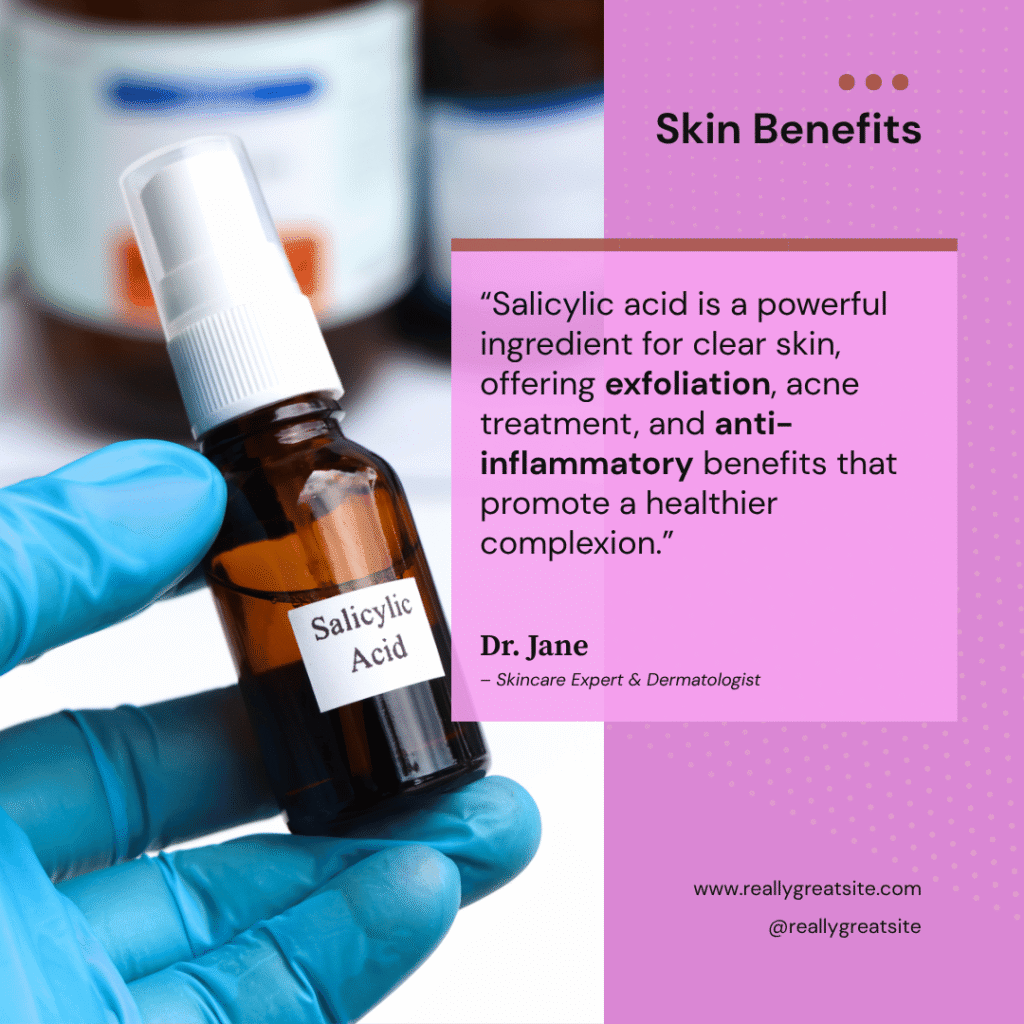
Salicylic acid has become a staple component in skincare products, particularly for people with acne or oily skin. Well-known for its ability to get deep into the pores, this beta hydroxy acid (BHA) efficiently dissolves extra oil and dead skin cells that may cause problems.
Regular salicylic acid inclusion in daily skincare routines helps greatly lower the frequency and severity of acne breakouts, thereby improving complexion.
Beyond its ability to combat acne, salicylic acid serves as a mild exfoliator that helps remove the surface layer of dead skin.
This natural exfoliating process improves general brightness and helps to smooth skin. Salicylic acid guarantees fresh, healthy skin is regularly brought to the surface by boosting cell turnover and improving attractiveness over time.
Salicylic acid also has advantages in terms of anti-inflammatory action. It can reduce redness and swelling related to inflammatory acne, therefore helping to calm irritated skin and provide comfort. This feature makes salicylic acid a perfect component not just for people with sensitive skin types seeking mild, efficient treatments but also for those prone to breakouts.
Including salicylic acid in your skincare regimen also promotes a better skin barrier. By controlling sebum production, one can avoid acne development and blocked pores, preventing long-term skin problems.
Stressing its part in a whole skincare program highlights salicylic acid’s transforming power. Regular use helps people not only have better skin but also boost their confidence in their looks.
Who should apply salicylic acid?
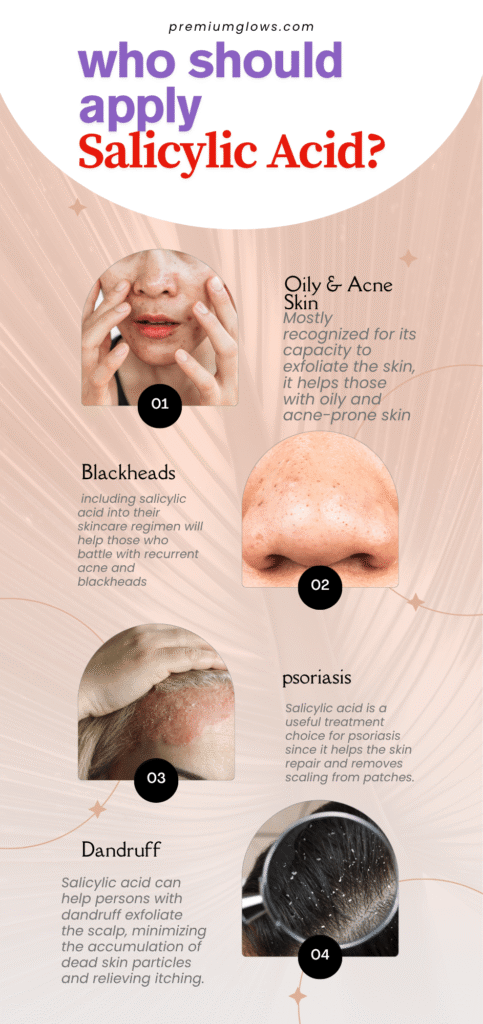
One flexible component that fits many skin types and conditions is salicylic acid. Mostly recognized for its capacity to exfoliate the skin, it helps those with oily and acne-prone skin, especially. Penetrating the pores, the salicylic acid efficiently dissolves dead skin cells and extra sebum, therefore preventing outbreaks.
Therefore, including salicylic acid into their skincare regimen will help those who battle with recurrent acne and blackheads.
It helps those with disorders like psoriasis and dandruff. Salicylic acid is a useful treatment choice for psoriasis since it helps the skin repair and removes scaling from patches. This acid can help persons with dandruff exfoliate the scalp, minimizing the accumulation of dead skin particles and relieving itching.
Though salicylic acid has several advantages, prospective users should consider skin type. People with sensitive or dry skin, for instance, could find it too strong, which would cause irritation or excessive dryness. Those with combination skin should also approach its use carefully since focused application would be more suitable than general use throughout the face.
See a dermatologist to determine if salicylic acid is appropriate for your skincare requirements; they can offer tailored advice depending on particular skin issues and types.
Salicylic acid offers many benefits for different people, notably for those with oily, acne-prone skin or several dermatological diseases. Effective use and maximum benefit from salicylic acid depend on knowing one’s skin type and issues.
How Salicylic Acid Benefits Various Skin Types
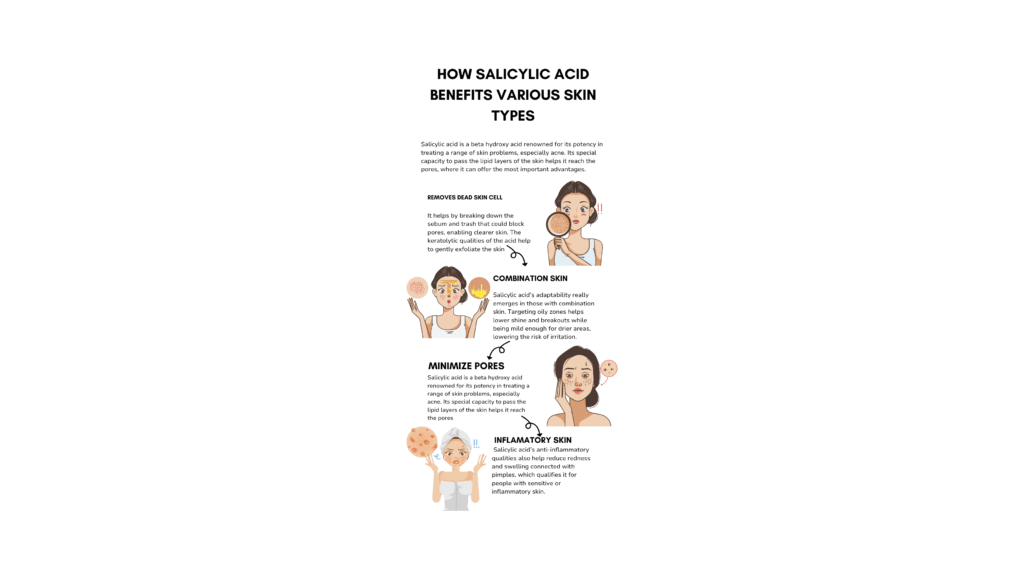
Salicylic acid’s anti-inflammatory qualities also help reduce redness and swelling connected with pimples, which qualifies it for people with sensitive or inflammatory skin.
Salicylic acid is a beta hydroxy acid renowned for its potency in treating a range of skin problems, especially acne. Its special capacity to pass the lipid layers of the skin helps it reach the pores, where it can offer the most important advantages. Fascinatingly different depending on skin type, salicylic acid works via a system that addresses particular problems precisely.
Because salicylic acid helps to reduce too high oil production, it is a great friend for oily skin. It helps by breaking down the sebum and trash that could block pores, enabling clearer skin. The keratolytic qualities of the acid help to gently exfoliate the skin, therefore facilitating the removal of dead skin cells that can support the development of acne. This ongoing exfoliation not only cleans pores but also aids in preventing outbreaks in the future.
Salicylic acid’s adaptability really emerges in those with combination skin. Targeting oily zones helps lower shine and breakouts while being mild enough for drier areas, lowering the risk of irritation. Salicylic acid’s anti-inflammatory qualities also help reduce redness and swelling connected with pimples, which qualifies it for people with sensitive or inflammatory skin.
Though salicylic acid can still be helpful for sensitive skin types, care should be used. Lower doses and formulations meant for sensitive skin are advised to help to minimize any possible irritation. Treating sporadic breakouts without aggravating sensitivity is made much easier by the acid’s capacity to lower inflammation.
Salicylic acid essentially fits different skin types and offers specific treatment for oily, combination, and even sensitive skin. Through its multifarious approach, it not only addresses particular issues, including excess oil, acne, and inflammation but also efficiently promotes better skin.
Benefits of salicylic acid for skin
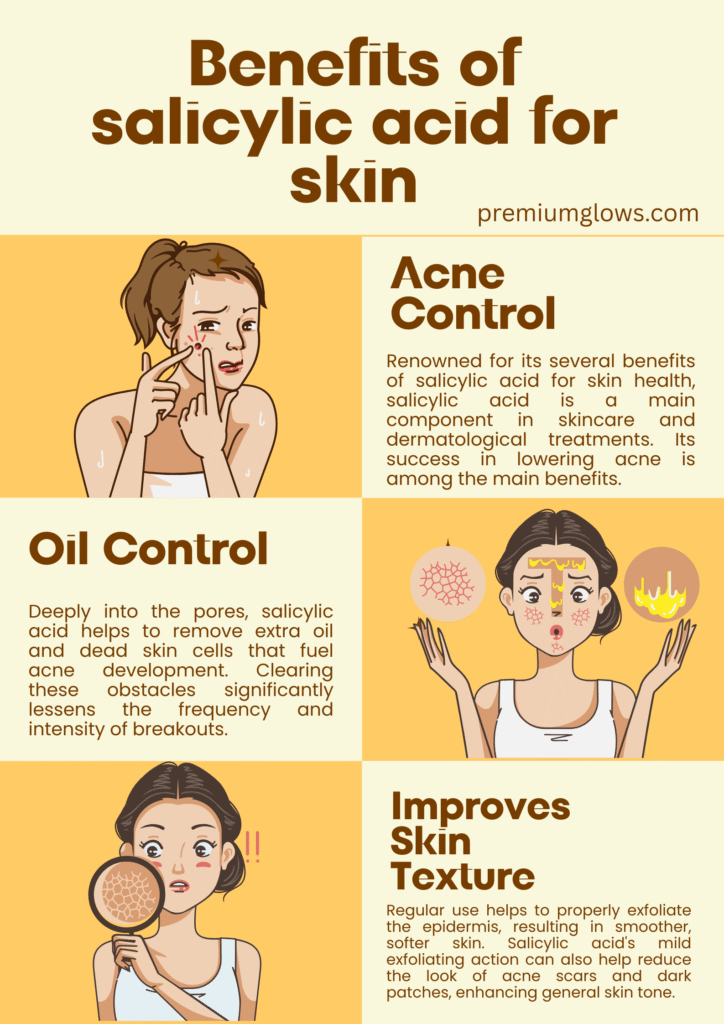
Renowned for its several benefits of salicylic acid for skin health, salicylic acid is a main component in skincare and dermatological treatments. Its success in lowering acne is among the main benefits. Deeply into the pores, salicylic acid helps to remove extra oil and dead skin cells that fuel acne development. Clearing these obstacles significantly lessens the frequency and intensity of breakouts.
Apart from improving acne, salicylic acid is absolutely essential for controlling oil. Acting as a keratolytic agent, it stimulates cell turnover and helps to slough off the top layer of skin. This not only lessens the surface oil content of the skin but also stops future clogged pore development.
Salicylic acid especially helps people with oily or mixed skin since it helps keep a more balanced complexion.
Another important advantage of salicylic acid is improved skin texture. Regular use helps to properly exfoliate the epidermis, resulting in smoother, softer skin. Salicylic acid’s mild exfoliating action can also help reduce the look of acne scars and dark patches, enhancing general skin tone. Moreover, it makes regenerating skin cells easier, which helps to give one a fresh and younger look.
Another prevalent worry among many people is the appearance of pores, which salicylic acid also reduces. Salicylic acid helps the pores seem smaller over time by keeping them free of dirt and grease. Therefore, adding salicylic acid to one’s skincare regimen solves current problems and helps long-term skin health by addressing several underlying skin conditions and encouraging general improvement of complexion.
Below we have given top 3 skincare products for skin.
Salicylic Acid for Hair Conditioning
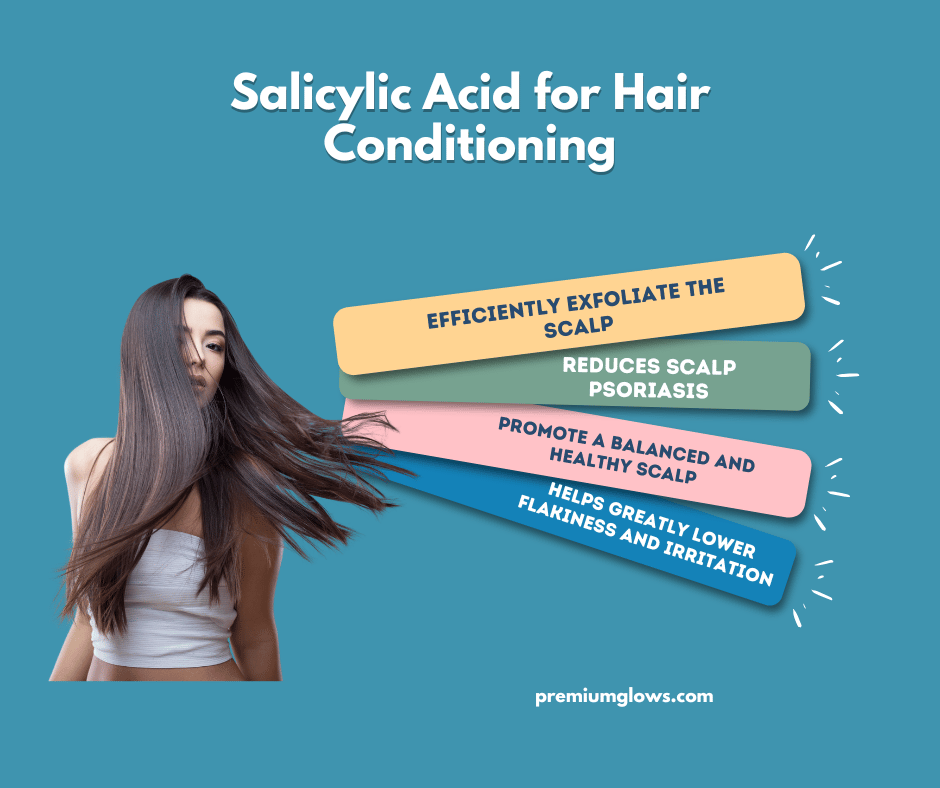
Although mostly used in skincare, salicylic acid also aids hair care, especially in addressing common scalp problems. One of its clear benefits is its capacity to efficiently exfoliate the scalp. Dissolving dead skin cells helps to stop the accumulation of build-up that could cause dandruff and other scalp disorders.
Many people’s common issue, dandruff, is usually brought on by dead skin cell collection and the development of yeast. Salicylic acid’s keratolytic characteristics encourage mild peeling, which helps greatly lower flakiness and irritation. Moreover, salicylic acid can help reduce irritation accompanying dandruff, creating a more cosy scalp environment.
Salicylic acid can also help with another upsetting disorder called scalp psoriasis. Red, scaly patches define this disorder, which can profit from salicylic acid’s capacity to reach deeply and encourage the shedding of extra skin. When included in treatment plans, salicylic acid helps persons with this chronic illness find respite by lowering flares and relieving inflammation.
Apart from addressing particular scalp problems, salicylic acid inclusion in hair care products can help maintain general hair vitality. A healthy scalp encourages more hair development, therefore lessening hair thinning and breakage. Salicylic acid guarantees that hair follicles may operate as they should by efficiently removing accumulation and preserving a better environment, therefore producing vivid and stronger hair.
All things considered, salicylic acid is a multifarious component used to support hair condition. Its exfoliating qualities and capacity to treat different scalp disorders greatly help hair care products that promote a balanced and healthy scalp.
Below we have listed 3 best hair care products.
- Luxurious anti-dandruff shampoo formulated with our highest 3% salicylic acid concentration. Fragrance-free, alcohol fre…
- Clinically Proven to control scalp flakiness, irritation & redness due to dandruff.
- Starts working from first use and keeps working long after the shampoo is rinsed off.
- SCALP RELIEF: This deep-conditioning scalp care is designed to be massaged into the scalp and rinsed out, helping to soo…
- CLEANS AND CONDITIONS: Formulated to cleanse while conditioning, this scalp care deeply nourishes and improves the skin …
- RECOGNIZED BY THE NATIONAL PSORIASIS FOUNDATION: Trusted for its efficacy, this salicylic acid deep conditioning scalp c…
Salicylic Acid and Human Anatomy
Not only is salicylic acid a central component in skincare and haircare products, but its advantages also apply to other body treatments. Renowned for its exfoliating qualities, this beta hydroxy acid works exceptionally well for treating disorders, including keratosis pilaris and body acne. Using salicylic acid can help to improve skin conditions all around the body.
For many people, especially in the back, shoulders, and chest, body acne can be a bothersome problem. Deeply penetrating the pores, salicylic acid dissolves dead skin cells, extra oil, and impurities, preventing breakouts. Salicylic acid also helps to minimize the appearance of current blems by encouraging cellular turnover, helping to avoid their development.
Salicylic acid in body washes or spot treatments might assist in particularly targeting these difficult regions.
Apart from treating body acne, salicylic acid helps those with keratosis pilaris, a common skin ailment marked by tiny, rough bumps usually present on the thighs and upper arms. With consistent usage of salicylic acid formulations, the keratin accumulation in this disorder can be rather lowered. Salicylic acid helps to unclog the blocked hair follicles causing these pimples and gently exfoliates the skin to provide a smoother texture.
Moreover, salicylic acid maintains a balanced complexion, enhancing general skin conditions. Its anti-inflammatory qualities are perfect for calming redness and irritated skin using reduction. For those with sensitive skin, this makes it a perfect component. Salicylic acid is a versatile agent for preserving good skin on the body since it improves skin clarity, texture, and general health when included in body care products.
Adding salicylic acid to your regimen
Including salicylic acid in your hair and skincare routines will greatly help with various problems, including dandruff and acne, and enhance skin condition. First, you have to decide which salicylic acid products fit your particular skin type and problems. Common formulas call for cleansers, toners, and spot treatments, all with different concentrations of this active component.
Start your salicylic acid regimen with a lower dose to gauge how sensitive your skin is. Most people would find a reasonable beginning point to utilizing a salicylic acid treatment two to three times a week.
If no irritation results, gradually up the frequency to daily use. For example, start using a cleanser with salicylic acid every other day and then move to regular use when your skin responds.
Combining salicylic acid with other skincare products should be approached carefully. Avoid using many exfoliants at once if you want the best results since this may cause excessive dryness or irritation.
To maintain moisture levels, combine salicylic acid with moisturizing agents such as glycerin or hyaluronic acid. Products based on salicylic acid should also be applied in the evening since this guarantees the best absorption and efficacy.
Sun protection takes the front stage when using salicylic acid. This active component can boost UV sensitivity, so using a broad-spectrum sunscreen throughout the daytime is quite important.
Those with sensitive skin should also give careful thought to doing a patch test prior to major application. Following this useful advice can help you properly include salicylic acid into your beauty routine, improving the general condition of your hair and skin.
Potential Side Effects and Thoughtfulness
Salicylic acid is a common component in skincare products, and it is very useful for treating acne and other skin problems. Like any active component, however, it has adverse effects that consumers should be informed of before including it in their beauty routine.
Skin irritation, dryness, and peeling are the most common adverse effects because salicylic acid exfoliates the skin, which can be strong at higher dosages, so these reactions are sometimes the outcome.
Those with sensitive skin types or pre-existing skin disorders like eczema should use salicylic acid carefully. Those who are pregnant or nursing should also see a healthcare practitioner before use.
For everyone considering salicylic acid, patch testing is a crucial step; applying a tiny bit to a covert region of the skin can assist in finding any side effects before mass distribution. This habit lowers the possibility of significant irritation and lets people evaluate their salicylic acid tolerance.
When choosing salicylic acid skincare products, safety and efficacy depend heavily on concentration. Generally fit for frequent use, most over-the-counter medicines have concentrations ranging from 0.5% to 2%. Higher concentrations, usually found in professional treatments, may help those with more serious skin issues; still, these should be advised and supervised by a dermatologist to prevent excessive discomfort.
Using salicylic acid requires a basic awareness of balancing possible dangers with advantages. Knowing these side effects and factors helps consumers properly use salicylic acid in their skincare regimens, thereby optimizing its benefits and reducing any negative effects.
Examining the several advantages of salicylic acid, one finds that this strong chemical is essential for improving general well-being and skin condition. Salicylic acid, a beta hydroxy acid, is highly praised for its capacity to deeply infiltrate the pores, thereby removing dead skin cells and clearing extra sebum. This quality makes it especially helpful for people suffering from blackheads, acne, and other skin flaws since it lets one have a more brilliant and clear complexion.
Moreover, salicylic acid serves purposes outside of skincare. Its antifungal and anti-inflammatory qualities are great for treating scalp disorders, including dandruff and seborrheic dermatitis.
Including salicylic acid in daily hair care regimens helps people have better hair and a healthier scalp. Salicylic acid’s capacity to meet different needs emphasizes its adaptability and suitability for many skin types and issues.
Conclusion:
Finally, implementing salicylic acid in everyday activities can produce long-lasting benefits that improve skin and general health. Starting with smaller doses will help users evaluate skin tolerance and progressively increase as needed. The secret is consistency and using appropriate moisturizers to complement salicylic acid, preserving hydration and treating skin conditions.
Although your experiences and outcomes may differ, sharing them might give others thinking about this transforming component insightful analysis. Encouragement of readers to investigate salicylic acid inclusion in their personal care toolkit for a complete approach to self-care, it has several advantages overall that can improve skin and hair condition.
Read More: The benefits of Niacinamide.




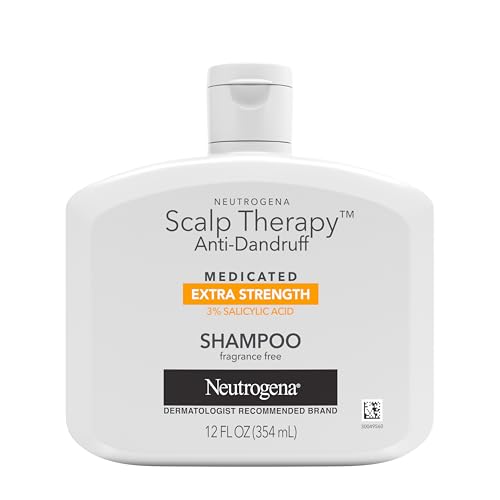




Leave a Reply